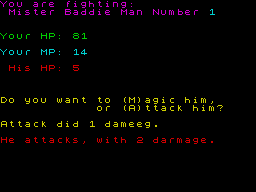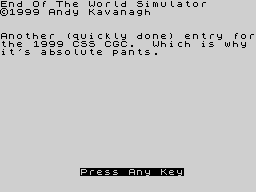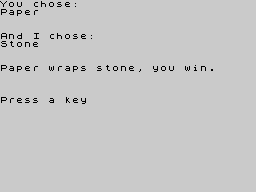RSG (1999)
Take ‘control’ of The Main Character Who Is The Good Guy and thwart the Powers Of Evil, manifested in the form of 20 Mister Baddie Men each one More Deadly Than The Last.
Gasp in awe at the tremendous array of moves available! Gape in stunned silence as you perform the Super Special Move, entirely By Accident! Wet your pants as you make it to the final stage, with only a scrape of energy left!
More addictive than tooth removal surgery, and more playable than Toenail Tiddlywinks, this IS the game of the decade. Provided that it is of course the Bartrokian Decade, as measured by the Bartrokians on planet Bartrok in a distant solar system, where a decade is in fact exactly equal to eighteen Earth seconds.
- Requires virtually no skill!
- Frighteningly realistic!
- A whole RPG in 6K of code!
Reviews:
“Its FANTASTIC!” – Me
“Its ABSOLUTELY BRILLIANT!!!” – David Darling
“YS Megagame!” – Your Sinclair
End Of The World Simulator (1999)
Not so much a game, more a realistic interpretation of the Last Days of Mankind.
Be stunned by the documentary-like quality of this simulation, so real that you have to keep telling yourself that it’s not really happening. Not one for the elderly or fainthearted.
- Groundbreaking realism!
- Crapolithic TechnologyTM!
- Graphic close-ups!
- No nodding dogs!
Reviews:
“My inspiration” – Douglas Adams
“Staggering” – Patrick Moore
“Ouch!” – Man walking into a bar
Scissors, Paper, Stone (1999)
No need for hands now! Paper, Scissors, Stone brings the playground game direct to YOUR SPECCY! No longer will you need to (or even be able, without the aid of a few extension cables, and an unbrella in case of rain) play in a playgound again!
An amazingly realistic recreation, SPS ranks high in the list of Most Played Speccy Games. Assuming the list was upside down.
- No Arms RequiredTM!
- All The Original Moves!
- Probably No Cheating!
- No Friends Required!
Reviews:
“I’m. I’m not helping much, am I daddy?” – Boy on old advert
“Stonking!” – Claire Raynor
“Yes” – Anyone at all

Many, many, many years ago, I wrote a terrible text based roleplaying game called RSG. I initially made a version for the Sinclair Spectrum, but lost the code soon afterwards. Then I wrote a version for the Acorn A4000 in BBC Basic instead of doing my A level computing project. Then a version for the Casio programmable calculator when I’d finished a physics exam. At some point I also made a version in AMOS on the Amiga, and eventually rewrote it for the Spectrum for the 1999 comp.sys.sinclair Crap Games Competition.
Since then, I’ve made a version (that didn’t work) in Flash, a version in Perl, and I even got part way through a port on the original Game Boy, until I ditched it and wrote Advanced Lawnmower Simulator for that instead.
But now! With the soon to be released Gamebuino, I’ve been learning Processing (again, I sort of learnt it a few years ago, but forgot it all again). And here is the fruit – a Processing written RSG. In a tiny, tiny little box. Why a tiny box? That’s the resolution of the Gamebuino!
https://lofi-gaming.org.uk/tools/processing/rsg/processing.jsfunction getProcessingSketchId () { return ‘RSG’; }
Yes. Yes, that is it in that little box there. Click on it and begin the greatest of all diminutive adventures!
Click to share on Twitter (Opens in new window)Click to share on Tumblr (Opens in new window)Click to share on Reddit (Opens in new window)Click to share on Pocket (Opens in new window)Click to share on Facebook (Opens in new window)MoreClick to email a link to a friend (Opens in new window)Click to share on LinkedIn (Opens in new window)Click to print (Opens in new window)
Related
Pingback: Finally! The version of RSG you’ve been waiting for! | deKay's Blog
(Another suggestion from @JayTay)
I’ve only ever been to Kempston once, and that was to go to Sainsbury’s in the middle of the night. I’ve driven through it a handful of times, though, and without wishing to offend those who live there, it is pretty unremarkable. Sinclair is not, as far as I’m aware, a location anywhere in the UK or any of the countries I’ve ever visited. With this deduction, I presume the comparison requested is between the two competing joystick interface standards for the Sinclair Spectrum.
That certainly makes more sense, anyway.
Notice that I said “joystick interface” rather than “joystick”. Although Sinclair, and probably Kempston, branded sticks existed, and games always referred to “Kempston Joystick” and so on, it was actually the interface that made the difference.
Unlike many other machines at the time, the Spectrum didn’t have any joystick ports built in, and wouldn’t until the +2 model came along. Instead, an interface device needed to be plugged into the computer’s edge connector, and joysticks were plugged into that. The joysticks themselves were actually standard Atari-compatible one-button sticks with 9-pin connectors, and could be used with either interface (or indeed most of the less common alternatives, like AGF and Fuller), or indeed with many other computers and consoles of the era.
To the player, that meant that there was no real difference between the two. In my experience, more (most, in fact) games supported Kempston as a default option, but the Sinclair interface was actually quite clever: It replicated number keys on the keyboard. If a game didn’t support joysticks but did support redefining the keys, then you could still use a stick. Of course, the Cursor joystick interface did the same, but that isn’t up for discussion. In addition, the Sinclair interface offered the capability to use two sticks at once – one replicating the keys 1-5, the other 6-0.
At a technical level, and I’m barely a machine code coder so bear with me, communicating with the interfaces was just as simple for each. You read hardware port 0x1f for Kempston, and either 0xf7fe or 0xeffe for the two Sinclair ports. However, as a BASIC programmer (which I’m infinitely more proficient at, I mean, have you not seen Octopus Lite?) reading joystick ports is slightly more complicated and unusual. Not so with Sinclair sticks as they register as keys, so a quick INKEY$ is all you need.
However. It was much, much easier, and cheaper, to get hold of a Kempston interface (not least because the official Sinclair ones also did other things besides just provide joystick sockets) so that’s what most Spectrum owners did. Kempston became the de facto standard for Speccy joystick interfaces, with some games equating the term “Joystick support” with support for the Kempston interface, and so effectively Kempston was best just for that reason.
Sinclair may have been more useful, but Kempston was King.
Click to share on Twitter (Opens in new window)Click to share on Tumblr (Opens in new window)Click to share on Reddit (Opens in new window)Click to share on Pocket (Opens in new window)Click to share on Facebook (Opens in new window)MoreClick to email a link to a friend (Opens in new window)Click to share on LinkedIn (Opens in new window)Click to print (Opens in new window)
Related